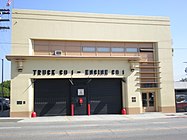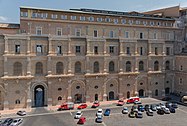Fire station
A fire station (also called a fire house, fire hall, or firemen's hall) is a structure or other area set aside for storage of firefighting apparatus such as fire engines and related vehicles, personal protective equipment, fire hoses and other specialized equipment. It may also have dormitory living facilities and work areas for the use of fire fighters. Living areas are sometimes arranged above the garage bays where personnel without specific station duties during the night shift are allowed to sleep unless a dispatch is called. In that situation, firefighters may have special means to allow entry to the ground floor quickly when a call for help is received, such as sliding down a brass pole called a fireman's pole. This arrangement also allows for a raised area to hang hoses to dry to prevent damage. In a single story station, a tower-like structure is sometimes used for hose hanging.
An occupied station will usually have a station alarm system for receiving and annunciating an alarm, and indications of where and what caused the alarm. However, sometimes the only "alarm" is a telephone that is rung in case of emergency. In a volunteer fire department where volunteers do not staff the station, the firefighters may be summoned to the fire station by siren, radio or pagers, making a station alarm system superfluous.

In a more structured operation, full-time or on-call volunteer or career firefighters staff the station some or all of the time. There may be office space for the officers, a library of reference and other materials, and a "trophy wall" or case where the firefighters display memorabilia.
Activities in a fire station include regular inspection and cleaning of the apparatus and equipment, and continuing education in the fire service. Weekly or bi-weekly routine typically includes various drills in which firefighters practice their skills. Some fire companies also host public activities at the fire station during annual "fire prevention week" or similar, and the facility may also be used for fund-raising by the "firemen's association", "fire buffs", or "fire auxiliary".
The approaches to a fire station are often posted with warning signs, and there may be a traffic signal to stop or warn traffic when apparatus are leaving or returning to the station.
In larger cities fire stations are often named for the primary fire companies and apparatus housed there, such as "Ladder 49", or the district which they serve. Rural fire stations are usually named for the county, town or village, but may also be named for the independent fire district serving a collective geographic area.
Gallery
-
Marblehead, Massachusetts, United States fire station
-
Historic Toronto Fire Services Fire Hall
-
LAFD Fire Station 1, Los Angeles, California, United States. This type of fire station in common in the Los Angeles Metropolitan Area
-
An urban fire house in Manhattan, New York City, built in 1894
-
A firehouse in the Pisek District of the Czech Republic
-
The Vatican City fire station, headquarters of Vatican fire brigade.
See also
References
- Notes
External links
- Olathe, Kan. Fire Department
- West Jackson Fire Department, GA
- Raleigh and Wake County, NC fire departments
- Killorglin Fire & Rescue, County Kerry, Ireland














